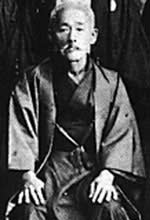Higaonna, Kanryo (1853-1910)

Higaonna Sensei was born in Naha-Shi, Okinawa, in 1853. His family lineage
was one of prominence in Okinawa. However, despite their former social
standing, they had become poor along with so many others that suffered
the effects of Okinawa's turbulent political history. They supported themselves
by transporting firewood from the Kerama Islands to Okinawa by boat. (1
- p. 44), (3 - # 2)
Higaonna Sensei, although muscular, was not very large overall and made
up for his lack in size by being lithe and quick. From his earliest years
he possessed a hunger for training in the arts. He began his training
at 14 years of age with an Okinawan man who had studied the Fukien style
of Chinese Kenpo. In 1877, he achieved his dream of traveling to China
to study the arts when he was granted passage onboard a ship bound for
Port Foochow. (1 - p. 47), (3 - # 2)
He lived in the Okinawan settlement in Foochow for a year before finally
being introduced to a local Gung Fu master named Liu Liu Ko. He was required
to do chores and tend to the master's garden for a period of time to show
his character and the sincerity of his desire to train seriously before
he was accepted as a student. He worked to help his master in the trade
of bamboo crafting during the day and trained at night. Sanchin Kata and
weight training were instrumental in his early training. The training
was severe and definitely a true test of Higaonna Sensei's will. He persevered
regardless of the training's intensity and eventually became one of Ryu
Ryuko's strongest students. (1 - pp. 47, 48), (3 - # 2)
Upon returning to Okinawa after 13 years of training in Foochow, Higaonna
Sensei repaid the man who had granted him passage to Okinawa by privately
teaching the art to his sons. Higaonna Sensei's reputation as a master
of Tou-Di / Tou-Ti (China Hand) quickly spread throughout the local community-mainly
because of the stories told by those returning from China. Many would
come to him in hopes of becoming disciples, but he taught as severely
as he had learned, and it was rare that a student continued for more than
a short while. (3 - # 2)
His teachings eventually came within the grasp of any that could persevere;
he began teaching at a public school in 1905. Because Naha is where he
lived when he began teaching, people knew his teachings as "The Hands
of Naha"; thus Higaonna Sensei's "style" came to be known
as "Naha-Te." (3 - # 2)
In his time, Higaonna Sensei-along with Itosu Anko-would come to be considered
"the foremost karate-ka in Okinawa." He died in October 1910,
at 62 years of age in the presence of Miyagi Chojun. Many of Higaonna
Sensei's students carried on to develop their own styles founded on his
teachings. His legacy continues through the achievements of these students
and those who would eventually follow them. The most prominent of them
were Miyagi Chojun (Goju-Ryu) and Mabuni Kenwa (Shito-Ryu). (1 - pp. 44,
48), (3 - # 2)
Author: Original material from: Wade Chroninger-Chief Instructor, Meibukan
Goju-Ryu, Okinawa Dojo, International Student Branch. Note: some wording
modifications were made to insure clarity to students outside of the Meibukan
Goju-Ryu organization. (Edited for punctuation and clarity)
Research Bibliography: Works Sited and / or Consulted
(1). Yagi Meitetsu, Carl Wheeler, and Brock Vickerson; OKINAWAN KARATE-DO
GOJU-RYU MEIBU-KAN, (pages 17, 22, 43, 44, 46 - 49, 53, 54); Published
by the authors, 1998; Printed in Prince Edward Island, Canada by Action
Press.
(2). TRADITIONAL KARATE-DO-Okinawa Goju Ryu Vol.1 Fundamental Techniques,
(pages 22 - 29); Published by Sugawara Martial Arts Institute, Inc. Of
Tokyo, Japan, 1997, Eighth Printing, 1985, First Printing; ISBN: 0-87040-595-0;
Printed in Japan
(3). Rob Monaco's Internet Site-pages: #1 http://gojuryu.net/miyagi.html
, #2 http://gojuryu.net/higaonna.html , #3 http://gojuryu.net/yagi.html
,
(4). John Porta's Internet Site-pages: #1 http://www.nserver.com/shobukan/gojuhist.html
, Note: This article originally appeared in the Journal of Asian Martial
Arts (Vol. 3, No. 3, 1994)
(5). Internet Web Site-page #1 http://www.smn.co.jp/keyword/0023k01e.html
, Article Title: OKINAWA: "Half a Century of American Military Bases
and the Okinawan People;" Authored by: Tetsuo Maeda, Military journalist;
(3/10/95)
(6). Alexander Lim Ko; FIVE ANCESTOR FIST KUNG-FU The way of Ngo Cho
Kun, (pages 31, 32); Published by Charles E. Tuttle Company. Of Rutland,
Vermont & Tokyo, Japan, 1997, first Tuttle addition; LCC Card Number
97-60011; ISBN 0-8048-3153-X; Printed in Singapore.
Reproduced with persmission from the Meibukan Website http://userhp.konnect.net/stones/
|